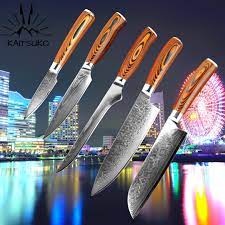Introduction:
Japanese Kitchen Knives are recognized for their sharpness. But there is a lot more directly to them than simply that—there are some various kinds of blades, steel compositions, and manage materials accessible on earth of Japanese Kitchen Knives. For many who aren’t knowledgeable about these knives, understanding what sets them aside can be a little bit overwhelming. That’s why we’ve created the following information on picking the best Japanese kitchen knife to suit your needs.
Forms of Blades
The most common type of blade employed in Japanese Kitchen knife (couteau) is definitely the single-bevel benefit. Which means that one area of your blade is sharpened whilst the other remains toned and unsharpened. Solitary-bevel ends are preferred mainly because they enable specific decreasing and chopping but call for far more recurrent sharpening because of the delicate mother nature. Twice-beveled sides, that are sharpened on aspects, can also be found and may even be easier to keep than a individual-bevel benefit after a while.
Metallic Formula
Japanese Kitchen Knives can come in a range of metallic compositions, from much softer stainless-steel alloys to more challenging co2 steels. Every type has its own positives and negatives for the way it will be utilized and preserved by the user. For example, gentler stainless steel alloys are less vulnerable to rust or deterioration but might require far more recurrent sharpening should they be employed frequently while harder carbon steels may carry a position longer but can corrode or even properly cared for. It’s crucial that you get to know various alloys prior to making a buying determination to help you find one that fits your needs finest.
Deal with Components
The handle fabric is also a significant thing to consider when choosing a knife—it should feel relaxed within your fingers and provide enough hold so it doesn’t slide when you’re working with it. Conventional Japanese manages are manufactured from wooden such as rosewood or ebony nonetheless, there are options available in steel or plastic for those who prefer one thing less classic yet still long lasting enough for everyday use.
Bottom line:
With the various sorts of blades, stainlesss steel compositions, and manage components readily available worldwide of Japanese Kitchen Knives, it may be demanding to choose the best one for you—but it doesn’t have to be! By familiarizing yourself with each type’s benefits and drawbacks you’ll be able to pick a knife that meets your needs flawlessly so that you can commence savoring precise slashes each time you prepare food! Regardless of whether you’re looking for one thing traditional or contemporary, with this particular manual you’ll manage to find exactly what you need!
